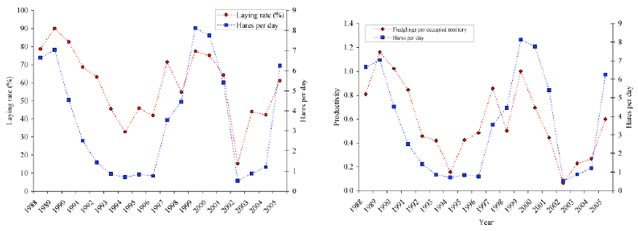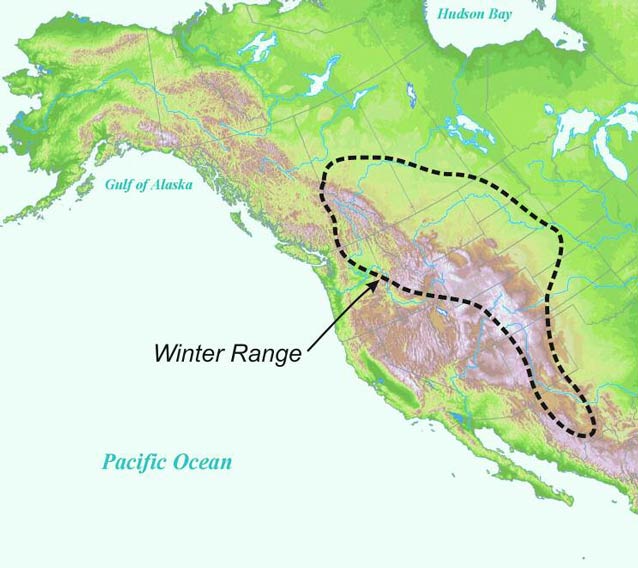
NPS Photo / Neal Herbert

NPS Photo / Carol McIntyre
Viewing predators is one of the highlights of a trip to Denali. Just a few years ago, visitors generally fixed their gaze on terra firma hoping to see a wolf or a grizzly bear.
Now, thanks to results of our long-term monitoring program for golden eagles ( Aquila chrysaetos), visitors frequently turn their eyes skyward in hopes of seeing one of North America’s largest aerial predators. With an abundance of cliffs and rock outcroppings for nest sites, as well as a diversity of prey, the northern foothills of the towering Alaska Range are well suited for this large aerial predator.
In the early twentieth century, Joseph Dixon and Adolph Murie recognized that golden eagles were integral components of this region’s fauna (Dixon 1938, Murie 1944). In 1987, Denali biologists conducted the first formal inventory of golden eagle nesting sites and found more than 50 occupied nesting territories in the northeastern region of Denali. This exciting discovery spurred the National Park Service to develop a long-term study of the nesting ecology and reproductive success of golden eagles in Denali.
To make comparisons with other study areas, Denali’s biologists modeled their new program after the long-term monitoring program in the Snake River Birds of Prey National Conservation Area in southwest Idaho (Steenhof et al. 1997, McIntyre and Adams 1999). This NPS study has provided internationally significant information on golden eagles (Watson 1997, Kochert and Steenhof 2002, Kochert et al. 2002) and some of our results are highlighted in this article.
Monitoring Reproductive Success
Denali’s golden eagles are migratory, and the territorial population occupies the foothills of the Alaska Range from March until October. A few hardy individuals may spend the winter, especially when snowshoe hare are abundant, but most return to their territories in March and begin repairing their nests.
Nests range in size, but all nests in our study area are built on cliffs or rock outcroppings (Figure 1). The female completes her clutch of one to three eggs by mid-April. Incubation requires about 42 days, most hatching occurs by early June, and most nestlings fledge by early August. The eaglets grow rapidly during the 70-day nestling period, and successful pairs raise from one to three nestlings (Figure 2).
We monitor the reproductive success of the eagles using two standardized aerial surveys annually from a small helicopter. In late April, after most clutches of eggs are completed, we observe all nesting territories to determine their occupancy and breeding status. We know that a territory is occupied if we observe a newly repaired nest or a pair of eagles engaged in territorial or reproductive activities.
Observation of an incubating eagle or eggs in a nest tells us that a laying pair is present. In late July, we count the number of nestlings and successful pairs (pairs that raise at least one fledgling) (Steenhof 1987). Data from these two surveys allows us to monitor nesting territory occupancy and reproductive success of golden eagles in Denali.

Providing New Information on Golden Eagles
Several of our studies have yielded exciting information about golden eagle nesting ecology. The results highlight the importance of the park to nesting golden eagles, and the importance of the eagles to visitors’ experiences.
Nesting densities are higher for golden eagles in Denali than anywhere else in North America (Figure 3) (Kochert et al. 2002). Occupancy rates are stable, and the territorial population consists mostly of adults. This suggests either that survival of territorial eagles is high or that sufficient numbers of non-territorial eagles (or floaters) are available to fill voids left by birds that die. Like many other northern predators, breeding golden eagles in Denali respond to the snowshoe hare cycle—more eagles lay eggs and raise more fledglings in years when snowshoe hares are abundant (Figure 4)(McIntyre and Adams 1999). Still, some pairs of eagles produce substantially more fledglings than others (McIntyre 2002), and productivity is significantly lower in areas with more closed-canopy vegetation (McIntyre 2004).
Our studies are particularly useful for comparing life history characteristics between migratory populations in northern latitudes and resident populations in southern latitudes in North America (McIntyre and Adams 1999, Kochert et al. 2002). For instance, mean brood size and overall productivity in Denali is lower than in most temperate study areas (McIntyre and Adams 1999). Additionally, the post-fledging dependence period is shorter and survival of juveniles is lower for Denali’s golden eagles than for resident populations at lower latitudes (McIntyre and Collopy 2006, McIntyre et al. 2006).

The Future of Denali’s Golden Eagles Although Denali’s landscapes are relatively free from habitat alteration directly attributed to humans, landscapes are dynamic and major perturbations will continue to shape their future. The cascading effects of global climate change may have profound effects on Denali’s landscape and its entire fauna. For example, climate change could cause regional changes in vegetation patterns (Rupp et al. 2000, Sturm et al. 2001), potentially affecting the habitat of many species of golden eagle prey (McIntyre 2004).
We live in a rapidly changing world. Humans have substantially altered much of the habitat in migration corridors and winter ranges of Denali’s golden eagles (Figure 5). Further, habitat alteration in areas bordering the park is also increasing. Long-lived, wide-ranging, slow reproducing animals such as golden eagles generally do not thrive in landscapes altered by human activities (Watson 1997, Kochert and Steenhof 2002). Long-term monitoring programs in the Snake River and in Denali provide valuable data to investigate responses of golden eagles to different environmental issues across diverse geographical areas (Kochert and Steenhof 2002). Will golden eagles thrive in Denali in the next century? Results of our long-term monitoring program in Denali, now a component of the Central Alaska Network Vital Signs Monitoring Program (MacCluskie and Oakley 2005), should provide answers to this and other questions.
References
Dixon, J.S. 1938.
Fauna of the National Parks of the United States. Birds and mammals of Mt. McKinley National Park. Fauna Series No. 3. U.S. Government Printing Office. Washington, D.C.
Kochert, M.N., and K. Steenhof. 2002.
Golden eagles in the U.S. and Canada; status, trends, and conservation challenges. Journal of Raptor Research 36 (1 Supplement):32-40.
Kochert, M.N., K. Steenhof, C.L. McIntyre, and E.H. Craig. 2002.
Golden Eagle (Aquila chrysaetos). In The Birds of North America, No. 684, edited by A. Poole and F. Gill. The Birds of North America, Inc. Philadelphia.
MacCluskie, M., and K. Oakley. 2005.
Vital Signs Monitoring Plan, Central Alaska Network, August 1, 2005. National Park Service. Fairbanks, Alaska.
McIntyre, C.L. 2002.
Patterns in nesting area occupancy and reproductive success of golden eagles (Aquila chrysaetos) in Denali National Park and Preserve, Alaska, 1988-99. Journal of Raptor Research 36 (1 Supplement): 50-54.
McIntyre, C.L. 2004.
Golden Eagles in Denali National Park and Preserve: Productivity and survival in relation to landscape characteristics of nesting territories. Ph.D. dissertation. Oregon State University. Corvallis, Oregon.
McIntyre, C.L., and L.G. Adams. 1999.
Reproductive characteristics of migratory golden eagles in Denali National Park, Alaska. Condor 101:115-123.
McIntyre, C.L. and M.W. Collopy. 2006.
The post-fledging dependence period of migratory golden eagles in Denali National Park and Preserve, Alaska. Auk, in press.
McIntyre, C.L., M.W. Collopy, and M.S. Lindberg. 2006.
Survival probability and mortality of migratory juvenile golden eagles from Interior Alaska. Journal of Wildlife Management, in press.
Murie, A. 1944.
The wolves of Mt. McKinley. Mt. McKinley Natural History Association. Mt. McKinley, Alaska.
Rupp, S.T., F. S. Chapin III, and A.M. Starfield. 2000.
Response of subarctic vegetation to transient climatic change on the Seward Peninsula in north-west Alaska. Global Climate Change Biology 6:541-555.
Steenhof, K. 1987.
Assessing raptor reproductive success and productivity. In Raptor Management Techniques Manual, edited by B.A. Giron Pendleton, B.A. Millsap, K.W. Cline, and D.M. Bird. Scientific Technical Series No. 10. National Wildlife Federation. Washington, D.C. 157-170.
Steenhof, K., M.N. Kochert, and T.L. McDonald. 1997.
Interactive effects of prey and weather on golden eagle reproduction. Journal of Animal Ecology 66:350-362.
Sturm, M., C. Racine, and K. Tape. 2001.
Increasing shrub abundance in the Arctic. Nature 411 (6837):546-547.
Watson, J. 1997.
The golden eagle. T & AD Poyser. London.
Part of a series of articles titled Alaska Park Science - Volume 5 Issue 1: Scientific Studies in Denali.
Last updated: November 1, 2022
